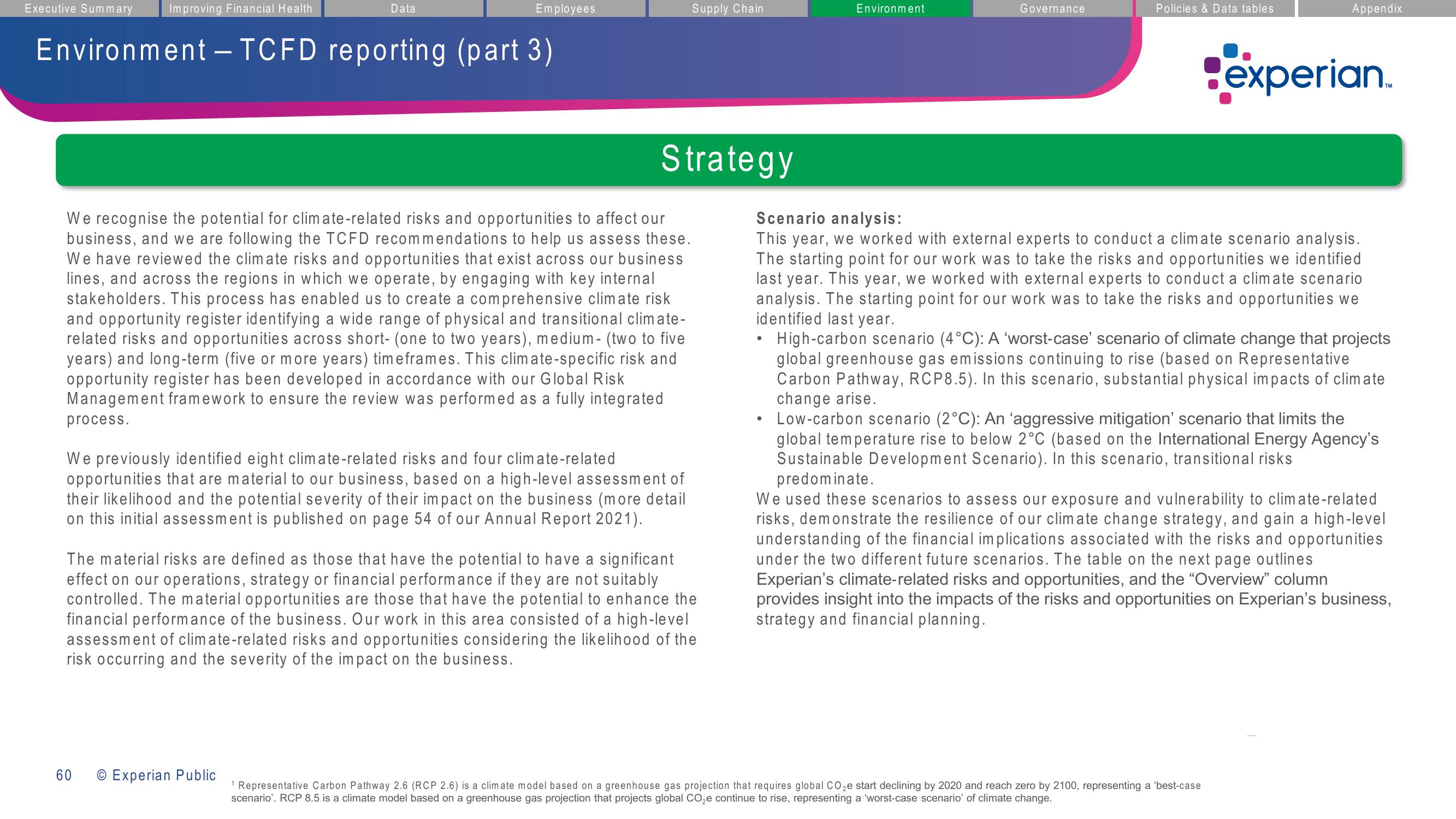Experian ESG Presentation Deck
Executive Summary
Environment - TCFD reporting (part 3)
Improving Financial Health
60
Data
Employees
We recognise the potential for climate-related risks and opportunities to affect our
business, and we are following the TCFD recommendations to help us assess these.
We have reviewed the climate risks and opportunities that exist across our business
lines, and across the regions in which we operate, by engaging with key internal
stakeholders. This process has enabled us to create a comprehensive climate risk
and opportunity register identifying a wide range of physical and transitional climate-
related risks and opportunities across short- (one to two years), medium- (two to five
years) and long-term (five or more years) timeframes. This climate-specific risk and
opportunity register has been developed in accordance with our Global Risk
Management framework to ensure the review was performed as a fully integrated
process.
We previously identified eight climate-related risks and four climate-related
opportunities that are material to our business, based on a high-level assessment of
their likelihood and the potential severity of their impact on the business (more detail
on this initial assessment is published on page 54 of our Annual Report 2021).
O Experian Public
1
Supply Chain
Strategy
The material risks are defined as those that have the potential to have a significant
effect on our operations, strategy or financial performance if they are not suitably
controlled. The material opportunities are those that have the potential to enhance the
financial performance of the business. Our work in this area consisted of a high-level
assessment of climate-related risks and opportunities considering the likelihood of the
risk occurring and the severity of the impact on the business.
Environment
●
Governance
Policies & Data tables
Appendix
Bexperian.
Scenario analysis:
This year, we worked with external experts to conduct a climate scenario analysis.
The starting point for our work was to take the risks and opportunities we identified
last year. This year, we worked with external experts to conduct a climate scenario
analysis. The starting point for our work was to take the risks and opportunities we
identified last year.
High-carbon scenario (4°C): A 'worst-case' scenario of climate change that projects
global greenhouse gas emissions continuing to rise (based on Representative
Carbon Pathway, RCP8.5). In this scenario, substantial physical impacts of climate
change arise.
Low-carbon scenario (2°C): An 'aggressive mitigation' scenario that limits the
global temperature rise to below 2°C (based on the International Energy Agency's
Sustainable Development Scenario). In this scenario, transitional risks
predominate.
We used these scenarios to assess our exposure and vulnerability to climate-related
risks, demonstrate the resilience of our climate change strategy, and gain a high-level
understanding of the financial implications associated with the risks and opportunities
under the two different future scenarios. The table on the next page outlines
Experian's climate-related risks and opportunities, and the "Overview" column
provides insight into the impacts of the risks and opportunities on Experian's business,
strategy and financial planning.
Representative Carbon Pathway 2.6 (RCP 2.6) is a climate model based on a greenhouse gas projection that requires global CO₂e start declining by 2020 and reach zero by 2100, representing a 'best-case
scenario'. RCP 8.5 is a climate model based on a greenhouse gas projection that projects global CO₂e continue to rise, representing a 'worst-case scenario' of climate change.View entire presentation